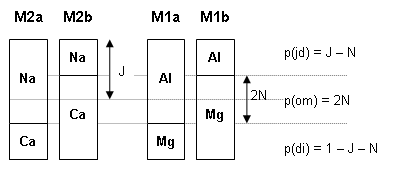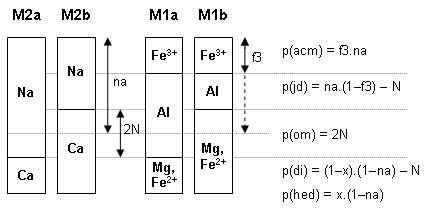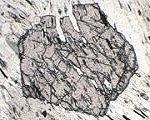Practical Aspects of Mineral Thermobarometry
Activity coding for omphacite and other sodic pyroxenes
NCMAS omphacite: jd - di - om
This model handles ordering in omphacites essentially as described in Holland and Powell (1996) Thermodynamics of order-disorder in minerals: II. Symmetric formalism applied to solid solutions. American Mineralogist, 81, 1425-1437. The model considers mixing on a split M1 site, in which M1a is presumed to prefer Al and M1b to prefer Mg. Na and Ca are presumed to be ordered in a coupled fashion on adjacent M2 sites.
It has been converted, with minor modifications, from an omphacite example file supplied with the version 2.7 download.

omp 3
J(omp) 0.5 % Na/(Na+Ca) or Al/(Al+Mg)
N(omp) 0.49 % 0.5(X(Al,M1a) - X(Al,M1b)) = half the order parameter Q
p(jd) 1 1 0 2 1 J -1 N % (J - N)
p(di) 1 1 1 2 -1 J -1 N % (1 - J - N)
p(om) 1 1 0 1 2 N % 2N
sf
W(jd,di) 26 0 0
W(jd,om) 16 0 0
W(di,om) 16 0 0
4
xAla 1 1 0 2 1 J 1 N
xAlb 1 1 0 2 1 J -1 N
xMga 1 1 1 2 -1 J -1 N
xMgb 1 1 1 2 -1 J 1 N
jd 1 2 xAla 1 xAlb 1
di 1 2 xMga 1 xMgb 1
om 1 2 xAla 1 xMgb 1
DQF -3.02 0 0
make 2 jd 1/2 di 1/2
The original file had a bulk composition formulation that differed from the proportions used to calculate gammas: this is no longer permitted.
NCFMAS omphacite: jd - di - hed - om
This model has been converted from the omphacite example file supplied with v. 2.7. The formulae for proportions are a little difficult to visualise, because although the ordered omphacite is still defined only in terms of di and jd, the model must also be able to reproduce bulk compositions and activities for highly ordered Fe-rich pyroxenes near hed50:jd50. These will clearly have to contain quite large negative amounts of diopside!
omp 4
x(omp) 0.1 % = Fe/(Fe+Mg)
J(omp) 0.5 % = Na/(Na+Ca) or Al/(Al+Fe+Mg)
N(omp) 0.25 % = 0.5(X(Al,M1a) - X(Al,M1b)) = half the order parameter Q
p(jd) 1 1 0 2 1 J -1 N % (J - N)
p(di) 2 2 1 1 -1 x 1 1 -1 J
1 0 1 -1 N % by difference (1-x)(1-J)-N
p(hed) 1 2 0 1 1 x 1 1 -1 J % x(1-J)
p(om) 1 1 0 1 2 N % 2N
sf
W(jd,di) 26 0 0
W(jd,hed) 24 0 0
W(jd,om) 16 0 0
W(di,hed) 4 0 0
W(di,om) 16 0 0
W(hed,om) 17 0 0
8
xAla 1 1 0 2 1 J 1 N
xAlb 1 1 0 2 1 J -1 N
xMga 1 2 1 2 -1 J -1 N 1 1 -1 x
xMgb 1 2 1 2 -1 J 1 N 1 1 -1 x
xFea 1 2 1 2 -1 J -1 N 0 1 1 x
xFeb 1 2 1 2 -1 J 1 N 0 1 1 x
xCaa 1 1 1 2 -1 J -1 N
xCab 1 1 1 2 -1 J 1 N
% XNa terms not explicitly required, as they are identical to the XAl terms
jd 1 2 xAla 1 xAlb 1
di 1 4 xCaa 0.5 xCab 0.5 xMga 0.5 xMgb 0.5
hed 1 4 xCaa 0.5 xCab 0.5 xFea 0.5 xFeb 0.5
om 1 3 xCab 0.5 xAla 1 xMgb 0.5
DQF -3.5 0 0
make 2 jd 1/2 di 1/2
Note that the activity terms have to be explicitly calculated over both split sites, the only simplification being that the Na and Al site fractions are identical.
Sodic pyroxenes without ordering
Some modellers appear to use a jd-di-hed model that does not involve ordering, but approximates omphacites by a simple one-site solution. We have used this for initial exploration of high-P systems in NCFMASH. I have not discovered the justification for the DQF increment applied to all end members.
cpx 3 % simple omphacite, 1-site ideal, no ordering (DJW 13/08/03)
x(cpx) 0.4 % Fe/Fe+Mg
n(cpx) 0.5 % Na/Na+Ca
p(di) 1 2 1 1 -1 x 1 1 -1 n
p(hed) 1 2 0 1 1 x 1 1 -1 n
p(jd) 1 1 0 1 1 n
ideal
3
x(Na,M2) 1 1 0 1 1 n
x(Mg,M1) 1 2 1 1 -1 x 1 1 -1 n
x(Fe,M1) 1 2 0 1 1 x 1 1 -1 n
% Ideal Mixing activities
di 1 1 x(Mg,M1) 1
DQF 1.3 0 0 % From Carson 99 and Will 98
hed 1 1 x(Fe,M1) 1
DQF 1.3 0 0
jd 1 1 x(Na,M2) 1
DQF 1.3 0 0
Sodic pyroxenes with ferric iron
Disordered C2/c solid solution di-hed-jd-ac
This coding essentially follows the formulation of the AX program for disordered Na-rich pyroxenes.
cpx 4 % Disordered C2/c solid solution di-hed-jd-ac hd(cpx) 0.2 % X(Fe2+,M1) jd(cpx) 0.3 % X(Al,M1) ac(cpx) 0.2 % X(Fe3+,M1) p(di) 1 1 1 3 -1 hd -1 jd -1 ac p(hed) 1 1 0 1 1 hd p(jd) 1 1 0 1 1 jd p(acm) 1 1 0 1 1 ac sf % W's from AX documentation W(di,hed) 3 0 0 W(di,jd) 24 0 0 W(di,acm) 24 0 0 W(hed,jd) 24 0 0 W(hed,acm) 24 0 0 W(jd,acm) 0 0 0 6 x(Ca,M2) 1 1 1 2 -1 jd -1 ac x(Na,M2) 1 1 0 2 1 jd 1 ac x(Mg,M1) 1 1 1 3 -1 hd -1 jd -1 ac x(Fe,M1) 1 1 0 1 1 hd x(Al,M1) 1 1 0 1 1 jd x(F3,M1) 1 1 0 1 1 ac di 1 2 x(Ca,M2) 1 x(Mg,M1) 1 hed 1 2 x(Ca,M2) 1 x(Fe,M1) 1 jd 1 2 x(Na,M2) 1 x(Al,M1) 1 acm 1 2 x(Na,M2) 1 x(F3,M1) 1
Sodic pyroxenes with ordering around omphacite
Here is an extension of the ordered omphacite model that adds the Fe3+ for Al substitution. The same device is adopted for the proportions of di and hed as in the model without Fe3+. Since aegirine-augite is disordered, Fe3+ is assumed to show no preference for any M1 sub-site. The resulting a-X relationships in the di-hed-jd-ac tetrahedron imply a transition from ordered to disordered pyroxene at about 25% acmite in omphacite at T = 500-550°C, in reasonable agreement with natural data from Oman and elsewhere.
The variable parameters are expressed as ratios. If I remember correctly this can be important in preventing parameters taking on negative values during calculation and causing THERMOCALC to fail.

cpx 5
x(cpx) 0.2 % = Fe/(Fe+Mg)
f3(cpx) 0.15 % = Fe3/(Al+Fe3)
na(cpx) 0.51 % = Na/(Na+Ca)
N(cpx) 0.4 % = 0.5(X(Al,M1a) - X(Al,M1b)) = half the order parameter Q
p(di) 2 2 1 1 -1 x 1 1 -1 na
1 0 1 -1 N % (1-x)(1-na) - N
p(hed) 1 2 0 1 1 x 1 1 -1 na % x(1-na)
p(jd) 2 2 0 1 1 na 1 1 -1 f3 % na(1-f3) - N
1 0 1 -1 N
p(acm) 1 2 0 1 1 na 0 1 1 f3 % f3.na
p(om) 1 1 0 1 2 N % 2N
sf
W(di,hed) 4 0 0
W(di,jd) 26 0 0
W(di,acm) 26 0 0
W(di,om) 16 0 0
W(hed,jd) 24 0 0
W(hed,acm) 24 0 0
W(hed,om) 17 0 0
W(jd,acm) 0 0 0
W(jd,om) 16 0 0
W(acm,om) 16 0 0
11
xAla 2 2 0 1 1 na 1 1 -1 f3
1 0 1 1 N % na(1-f3) + N
xAlb 2 2 0 1 1 na 1 1 -1 f3
1 0 1 -1 N % na(1-f3) - N
xFe3 1 2 0 1 1 na 0 1 1 f3 % f3.na
xMga 1 2 1 2 -1 na -1 N 1 1 -1 x % (1-na-N)(1-x)
xMgb 1 2 1 2 -1 na 1 N 1 1 -1 x % (1-na+N)(1-x)
xFea 1 2 1 2 -1 na -1 N 0 1 1 x % (1-na-N)x
xFeb 1 2 1 2 -1 na 1 N 0 1 1 x % (1-na+N)x
xNaa 1 1 0 2 1 na 1 N % na+N
xNab 1 1 0 2 1 na -1 N % na-N
xCaa 1 1 1 2 -1 na -1 N % 1-na-N
xCab 1 1 1 2 -1 na 1 N % 1-na+N
di 1 4 xCaa 0.5 xCab 0.5 xMga 0.5 xMgb 0.5
hed 1 4 xCaa 0.5 xCab 0.5 xFea 0.5 xFeb 0.5
jd 1 4 xNaa 0.5 xNab 0.5 xAla 0.5 xAlb 0.5
acm 1 3 xNaa 0.5 xNab 0.5 xFe3 1
om 1 4 xNaa 0.5 xCab 0.5 xAla 0.5 xMgb 0.5
DQF -3.5 0 0
make 2 jd 1/2 di 1/2
This page last modified 2 November 2004
